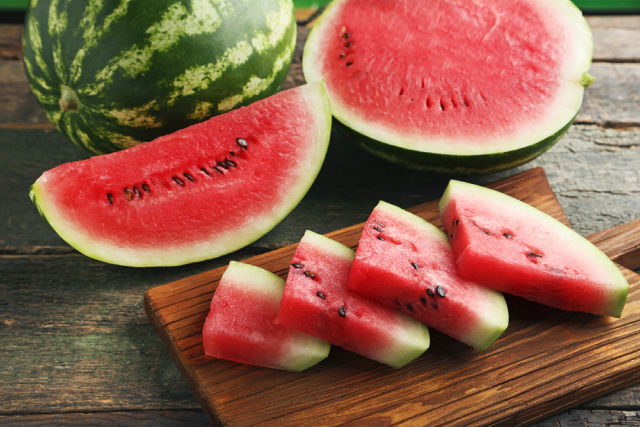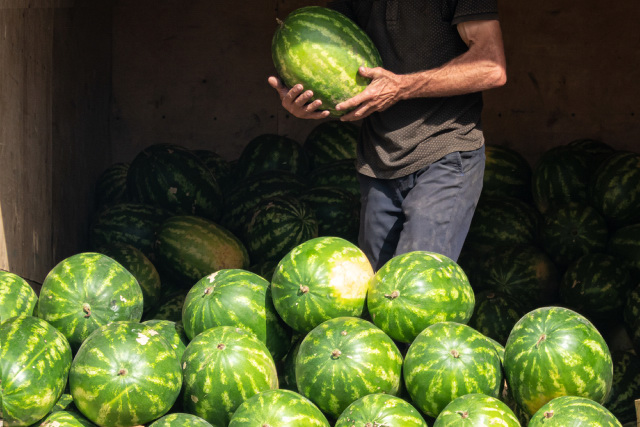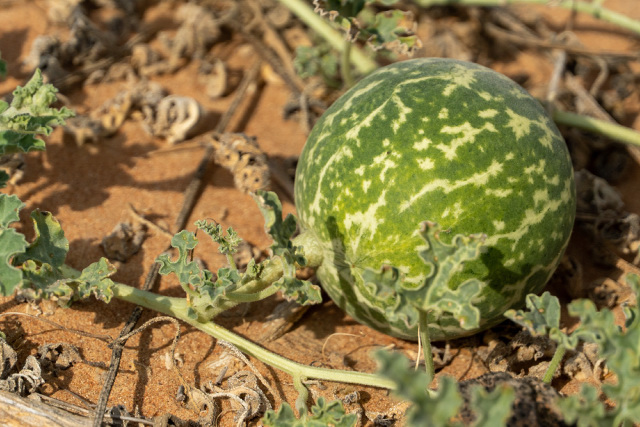Whenever summer starts, I find myself craving watermelon. A good juicy watermelon tastes sweet and is incredibly refreshing on a hot summer day. So what do you do if you grow or purchase a watermelon that tastes bitter? Keep reading to discover why this can happen and how to fix it.

Table of Contents
- Why Is My Watermelon Bitter?—The Short Answer
- How Growing Conditions Can Affect Watermelon Taste
- How Storing and Transporting A Watermelon Can Affect Its Taste
- The Colocynth—An Imposter Watermelon
- How Does The Age of A Watermelon Affect Its Taste?
- Is It Dangerous to Eat A Bitter Watermelon?
- Can I Tell If A Watermelon Will Taste Bitter?
- How Should I Grow Watermelon For The Best Taste?
- How Can I Sweeten a Watermelon?
Why Is My Watermelon Bitter?—The Short Answer
Watermelon should always have a refreshing and juicy pulp that’s pleasing to the taste buds. Therefore, if you eat a piece of watermelon that tastes bitter, it most likely has to do with how it was grown, how it was stored or transported, the variety of watermelon, or its age.
How Growing Conditions Can Affect Watermelon Taste
Chemical Additives
Some farmers of commercially-grown watermelons treat them with specific substances and chemical additives to hasten growth, improve appearance, or help them survive transport better.
One of the most common methods is to treat the ovaries of the watermelon plants with nitrates (in fertilizer), which allows them to gain weight more quickly and therefore ripen faster. Another common additive is potassium permanganate, which helps deepen the watermelon fruit’s red color inside.
Both of these situations, and some other types of additives, can affect the natural ripening process of the watermelon fruit. They can also impede the development of its sugars, leading to a bitter-tasting watermelon.
The best way to ensure that you eat watermelons grown without chemical additives is to grow them in your garden, purchase them from a reputable local farmer or buy organic. Also, try to only purchase watermelons during the peak months of August through September. Watermelons sold outside of their peak months are likely treated with chemicals that hasten growth.
Watermelon Crop Placement
If you grow watermelons in your home garden, the location in which you place them can affect their taste as well. Although you won’t notice the effect until the following year’s crop.
For example, if you grow your cucumbers next to your watermelon one summer and then save the seed from the watermelon to plant in your garden the following year, you may grow slightly bitter-tasting watermelons. This phenomenon is due to the cucumber cross-pollinating with the watermelon and affecting the seed.
Watermelon Diseases
Certain diseases specific to watermelons can also affect the taste of their fruit. Although you would likely not find these diseased fruits for purchase in a supermarket, if you grow your watermelons, you should become familiar with them, so you will recognize if a watermelon is of poor quality.
Some of the most common watermelon diseases that affect taste include:
- Bacterial fruit blotch
- Downy Mildew
- Powdery Mildew
- Anthracnose
If your watermelon crop is affected by one of these diseases and not treated, it could produce lower-quality watermelon fruit that tastes bitter or unpleasant.
How Storing and Transporting A Watermelon Can Affect Its Taste

Incorrect storage of a watermelon crop can also negatively affect its taste. Uncut watermelons can have a shelf life of 3-4 months if you keep them in a dark room at a temperature of about 35 to 46 degrees °F (2 to 8 degrees °C).
If the watermelon is not kept in these ideal conditions during storage, transportation, or delivery, bacteria could grow and enter through small cracks in the rind. As this bacteria multiples, the fruit starts to spoil, and changes taste from sweet to bitter and sour.
Additionally, if you purchase a pre-cut and packaged watermelon from the supermarket, it may also have a bitter or unpleasant taste. This taste is from exposure of the inside of the fruit to the environment, which may also lead to bacteria growth.
It is always best when purchasing a watermelon from a grocery store to only purchase whole, uncut melons.
At home, store your uncut watermelons in a cool, dark place. When you cut the watermelon, put it into an airtight container and store it in the refrigerator to maximize its shelf-life.
Finally, sometimes commercial watermelons are treated with ethylene during transport to increase the shelf life of the fruit. However, this gas causes the watermelon pulp to break down and become bitter, with coarse fibers appearing throughout it.
The Colocynth—An Imposter Watermelon
A particular variety of melon, a colocynth (also known as bitter cucumber or bitter apple), tends to look like a sweet watermelon from the outside, but the inside fruit tastes very different. It belongs to the pumpkin family. However, as the name suggests, the fruit inside of these melons is very bitter.
You likely will not encounter these melons in your supermarket or have them growing in your garden. They typically are grown in Arabic countries, India, and North Africa. However, it is important to recognize that although these melons can look like watermelons, they do not have nearly the same taste.
Eating a colocynth can also cause undesirable digestive issues and make you very sick due to the glycosides.

How Does The Age of A Watermelon Affect Its Taste?
As a watermelon starts to go bad or become overripe, it will also affect the taste of the fruit. An overripe or bad watermelon can start to taste bitter.
The best way to determine if your watermelon is going bad is through the color, smell, texture, and taste. If possible, always leave your watermelon uncut until you are ready to eat it to help it last longer.
If your watermelon is uncut, you can tell that it is starting to spoil by checking for the following things:
- Mold (dark spots) on the outside of the watermelon.
- Any change in color on your watermelon skin that looks abnormal.
- The watermelon sounds hollow when you tap it.
- The watermelon is starting to feel soft when you press on it.
If you notice any of these things with your uncut watermelon, you should discard it.
If you’ve already cut your watermelon, you can determine that it is going bad by checking the following:
- The watermelon has a bad smell to it.
- The color of the cut watermelon changed in any way.
- The taste of it is bitter or sour and tangy.
- The seeds are detaching from the flesh, or the watermelon has a hole in the middle of the flesh.
As with an uncut watermelon, if you notice any of these indicators, you should discard and not eat the watermelon.
Is It Dangerous to Eat A Bitter Watermelon?
You most likely would not want to continue to eat a bitter watermelon simply due to the taste. Still, you should also not eat a bitter-tasting watermelon because it could potentially make you feel sick.
As mentioned, one cause of bitterness in watermelon could be from chemical additives in the soil (such as fertilizers) that enter the fruit and lead to a build-up of nitrates. Excessive amounts of nitrates in a watermelon cause an excess of cucurbitacins.
While cucurbitacins are a naturally-occurring substance, too much can cause issues. If a watermelon with excessive cucurbitacins is consumed, it could cause digestive upset, nausea, and even dizziness.
If you suspect that cucurbitacins are the cause of the bitterness of the pulp of the watermelon, it is best to throw it out and not eat it to avoid feeling unwell.
Can I Tell If A Watermelon Will Taste Bitter?
When shopping for a watermelon or assessing a grown watermelon for its taste, a few general rules will help you to ensure you pick a sweet-tasting fruit.
- Purchase watermelons in their peak growing season (August through September)
- Look for a watermelon about 11 to 15 lbs (5 – 7 kg) in weight
- Listen to the sound when you tap the watermelon. It should make a resonating sound.
- The tail area of the watermelon (where it was attached to the stem) should be dry.
- A yellow spot on the side of the watermelon indicates that it was lying on the ground to ripen naturally (which is a good thing!).
How Should I Grow Watermelon For The Best Taste?
I’ve successfully grown watermelon in my garden numerous times. To ensure that my crop is healthy and has a nice sweet flavor, I make sure that I follow these tips.
Give The Watermelon Enough Space
Watermelons need plenty of space to grow. Some vines can reach more than 20 feet in height, and the fruit is very large. Although I plant multiple seeds in a group at the start, I make sure to place each group at least four feet from each other. Then, when the plants start to grow, I thin out each group, only keeping the strongest-looking plant.
Make Sure That You Have Good Soil
I amend the soil in the area where I plan to grow the watermelons with manure like this one. Then, I add an organic fertilizer like this one when planting.
Don’t Overwater The Watermelons
You should only need to water your watermelons once or twice a week during the growing period (depending on your climate) and when you do, avoid getting the soil sopping wet. I always ensure I avoid watering the foliage, as it could lead to fungi development, like powdery mildew. Finally, when I know that my watermelons are close to ripening, I cut back on their water. This step encourages sweetness in the melon.
Stay On Top Of Weeding
Many gardeners mulch their watermelon crops to help cut back on weeds and protect the moisture. I noticed a difference when I did this step for my own crop. When the watermelon plants were young, I made sure to weed them thoroughly. As the watermelon vines started to develop fully, I put mulch down to discourage the growth of additional weeds.
How Can I Sweeten a Watermelon?
You should generally refrain from eating a bitter watermelon because, as discussed, it could make you unwell. However, if you know that the slightly bitter taste of your watermelon has to do with it being a bit overripe but not yet spoiled, you can help “sweeten” it by sprinkling some salt on it the cut slices. The salt contrasts with the watermelon’s natural sugars, bringing out the sweetness.
Related Reading:
- Easy Watermelon Salad Recipe with Feta, Mint, Balsamic
- Eating Watermelon Rind With Recipe Ideas
- Why Is My Cantaloupe Sour? Answered!
- Watermelon Plant Dying? Causes and Solutions
- Kiwano Melon: Grow African Horned Melon and Eat the Fruit
- Watermelon Flowers But No Fruit? Causes and Solutions
- Why Are My Watermelons Not Ripening? With Solutions!
